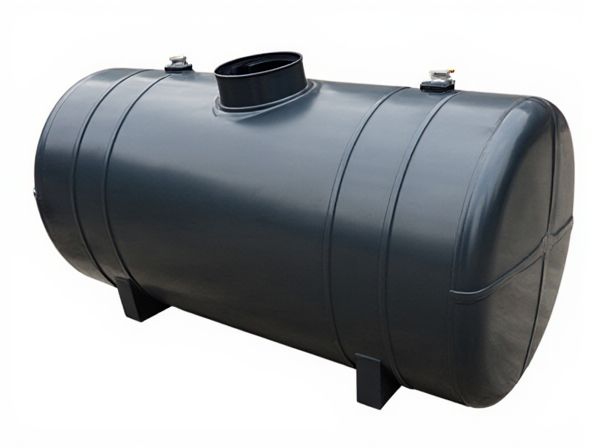
Photo illustration: Pressurized Tank vs Non-Pressurized Tank
Pressurized tanks maintain a constant internal pressure, ensuring efficient and controlled fluid delivery, while non-pressurized tanks rely on gravity or external forces for fluid movement. Your choice depends on the application's requirements for pressure control, safety, and system complexity. Pressurized tanks offer faster response times and better prevention of contamination compared to non-pressurized options.
Table of Comparison
| Feature | Pressurized Tank | Non-Pressurized Tank |
|---|---|---|
| Operating Principle | Maintains internal pressure to control fuel flow | Relies on atmospheric pressure, no internal pressurization |
| Fuel Evaporation | Minimizes evaporation with sealed design | Higher evaporation due to venting |
| Safety | Higher safety by preventing vapor leaks and explosions | Lower safety; prone to vapor release |
| Fuel Delivery | Consistent fuel pressure for efficient combustion | Variable pressure, may affect engine performance |
| Cost | Higher manufacturing and maintenance cost | Lower cost and simpler design |
| Common Use | Modern vehicles, especially with fuel injection | Older models and carbureted engines |
Introduction to Pressurized and Non-Pressurized Tanks
Pressurized tanks maintain internal pressure above atmospheric level to store gases or liquids safely, enabling efficient transport and controlled dispensing in industries like chemical processing and fuel storage. Non-pressurized tanks operate at atmospheric pressure, commonly used for storing liquids such as water and oils, where pressure buildup is minimal or unwanted. The choice between pressurized and non-pressurized tanks depends on substance volatility, storage requirements, and safety considerations.
How Pressurized Tanks Work
Pressurized tanks maintain a specific internal pressure using compressed air or inert gases to store liquids or gases safely, preventing contamination and enabling efficient dispensing. The pressure inside the tank forces the contents out through valves or pipes without the need for external pumps, ensuring consistent flow and minimizing exposure to outside air. These tanks are commonly used in industrial applications, chemical storage, and beverage dispensing systems where controlled pressure is crucial for operational safety and product integrity.
How Non-Pressurized Tanks Work
Non-pressurized tanks store liquids using atmospheric pressure, allowing fluids to flow through gravity or pump systems without the need for internal pressurization. These tanks rely on structural design elements such as venting to maintain pressure equilibrium with the environment, preventing damage or collapse. Common in applications like water storage and chemical containment, non-pressurized tanks offer a cost-effective solution where pressurization is unnecessary.
Key Differences Between Pressurized and Non-Pressurized Tanks
Pressurized tanks maintain internal pressure higher than atmospheric pressure to store gases or liquids safely, enabling efficient dispensing and preventing contamination. Non-pressurized tanks operate at atmospheric pressure, relying on gravity or external pumps for fluid movement, making them suitable for storing non-volatile liquids. Key differences include structural design strength, with pressurized tanks requiring thicker walls and safety valves, while non-pressurized tanks have simpler construction and are less costly.
Advantages of Pressurized Tanks
Pressurized tanks offer superior efficiency by maintaining consistent fluid flow without the need for external pumps, reducing energy consumption and operational costs. Their sealed design prevents contamination and evaporation, ensuring the purity and longevity of stored liquids. Enhanced safety features in pressurized tanks minimize the risk of leaks and spills, making them ideal for volatile or hazardous materials.
Benefits of Non-Pressurized Tanks
Non-pressurized tanks offer enhanced safety by eliminating the risks associated with high-pressure containment, making them ideal for storing sensitive or volatile liquids. They require less complex infrastructure, reducing installation and maintenance costs while improving operational efficiency. Their simpler design allows for easier inspection, cleaning, and repair, promoting longer lifespan and environmental compliance.
Common Applications of Pressurized vs Non-Pressurized Tanks
Pressurized tanks are commonly used in industries requiring controlled storage of gases and liquids under pressure, such as in chemical processing, oil and gas, and firefighting systems. Non-pressurized tanks are typically utilized for storing water, wastewater, and other non-hazardous liquids in agricultural, municipal, and food processing applications. The choice between pressurized and non-pressurized tanks depends on factors like the need for containment under pressure, safety requirements, and the physical properties of the stored substance.
Maintenance Requirements for Each Tank Type
Pressurized tanks require regular inspections for pressure integrity, valve functionality, and corrosion to prevent leaks or ruptures, often involving specialized equipment and trained personnel. Non-pressurized tanks generally demand less frequent maintenance, focusing primarily on structural integrity and cleaning to avoid contamination and corrosion. Both tank types benefit from periodic monitoring, but pressurized tanks have stricter regulatory standards and more complex maintenance protocols due to safety risks.
Safety Considerations and Risks
Pressurized tanks pose higher safety risks due to the potential for explosive decompression, requiring robust materials and regular inspections to prevent catastrophic failures. Non-pressurized tanks reduce the risk of rupture but may suffer from structural damage or leaks under external impacts, demanding proper maintenance and protective housing. Safety protocols for both types emphasize monitoring pressure levels, corrosion, and mechanical integrity to mitigate hazards effectively.
Choosing the Right Tank for Your Needs
Choosing the right tank depends on storage requirements and safety considerations, with pressurized tanks ideal for containing gases or volatile liquids under controlled pressure to prevent leaks and maintain product integrity. Non-pressurized tanks suit storing liquids or solids that do not require pressure containment, offering simpler design and lower maintenance costs. Evaluate factors like material compatibility, pressure tolerance, and intended application to determine the optimal tank type for your specific needs.
 caratoz.com
caratoz.com